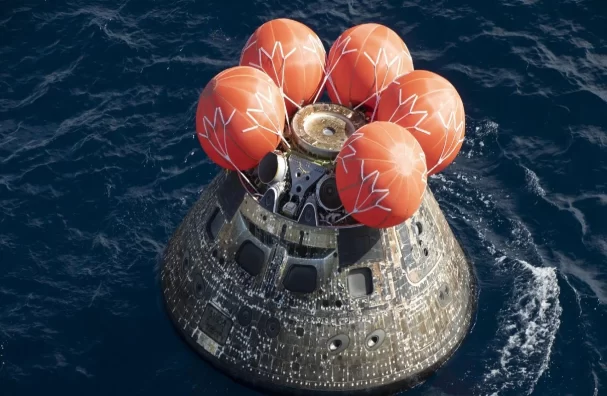
NASA gears up for the highly anticipated Artemis II mission, a recent report from the agency’s independent inspector general has cast a spotlight on the unresolved issues surrounding the Orion spacecraft’s heat shield. The assessment, released on Wednesday, delves into NASA’s preparedness for the forthcoming deep space endeavor, slated for September 2025. While the findings don’t unveil groundbreaking revelations, they underscore the gravity of the heat shield conundrum – a hurdle that could potentially derail the ambitious timeline.
During the uncrewed Artemis I mission in late 2022, the Orion capsule’s heat shield exhibited unexpected damage and charring upon its fiery re-entry into Earth’s atmosphere at a blistering speed exceeding 25,000 mph. Initially downplayed by NASA, this anomaly has since emerged as a significant concern, with the agency still grappling to unravel the root cause.
Amit Kshatriya, the pivotal figure overseeing the Artemis missions’ development within NASA’s exploration division, candidly acknowledged the ongoing investigation into the heat shield’s performance just last week. His remarks underscore the agency’s determination to resolve this perplexing enigma before proceeding with crewed missions.
While the inspector general’s report doesn’t offer groundbreaking revelations, it does shed light on previously undisclosed details. Notably, two striking images reveal the extent of the deep divots sustained by the Orion heat shield during the Artemis I mission. These visual aids underscore the gravity of the situation and the imperative nature of resolving the issue before risking human lives.
Perhaps the most intriguing aspect of the report is NASA’s response, which exudes a distinct tone of exasperation. Catherine Koerner, the associate administrator overseeing exploration systems development, expressed her frustration with the inspector general’s recommendations, deeming them “redundant” and “unhelpful” in ensuring the agency’s programs are organized, managed, and implemented efficiently.
This candid retort, likely reviewed and approved by senior NASA officials, suggests that the agency is feeling the mounting pressure to deliver on the Artemis program’s ambitious goals. With Congress closely monitoring the progress, any potential delays could have far-reaching implications.
The political undercurrents surrounding the Artemis missions were further underscored during a recent House Science, Space, & Technology Committee hearing. Chairman Frank Lucas wasted no time in addressing the possibility of modifying the Artemis III mission profile, citing an Ars Technica article that explored NASA’s internal deliberations on having Orion dock with SpaceX’s Starship in low-Earth orbit.
This line of questioning highlights the intense scrutiny and high-stakes nature of the Artemis program, with lawmakers keenly attuned to any potential changes or setbacks.
As NASA navigates these challenges, it’s evident that the road to the Moon is paved with formidable obstacles. The heat shield conundrum, coupled with the political pressures and the sheer complexity of deep space exploration, presents a formidable test for the agency.
However, NASA’s unwavering commitment to continuous improvement and risk mitigation is commendable. The agency’s dedication to addressing potential deficiencies and enhancing processes and procedures underscores its resolute pursuit of safety and efficiency.
The Artemis II mission stands as a pivotal juncture in NASA’s ambitious journey to establish a sustained human presence on the lunar surface. While the uncrewed Artemis I mission was a resounding success, the agency now faces the daunting task of ensuring the safety and reliability of the Orion spacecraft for its first crewed deep space voyage in over half a century.
As the countdown to September 2025 ticks away, all eyes will be on NASA’s efforts to resolve the heat shield enigma. The agency’s ability to overcome this hurdle will not only determine the fate of Artemis II but also shape the trajectory of future lunar exploration endeavors.
Throughout its storied history, NASA has consistently demonstrated an unwavering commitment to perseverance and ingenuity in the face of seemingly insurmountable challenges. From the triumphs of the Apollo era to the awe-inspiring achievements of the Space Shuttle and International Space Station programs, the agency has time and again defied the odds and pushed the boundaries of human exploration.
As the world eagerly awaits the next chapter in humanity’s cosmic odyssey, there is little doubt that NASA’s brightest minds are tirelessly working to unravel the mysteries of the Orion heat shield. Their dedication and expertise, combined with the agency’s vast resources and cutting-edge technology, offer a glimmer of hope that this perplexing puzzle will be solved, paving the way for a successful Artemis II mission.
The Artemis program represents more than just a series of ambitious missions – it heralds a renewed era of space exploration, one that promises to unlock unprecedented scientific discoveries and inspire generations to come. As humanity sets its sights on the Moon once again, the lessons learned and the challenges overcome will lay the foundation for even grander endeavors, such as the long-awaited journey to Mars.
In this grand cosmic narrative, the Orion heat shield conundrum may well be remembered as a pivotal chapter – a testament to the indomitable human spirit and our relentless pursuit of knowledge and exploration.
